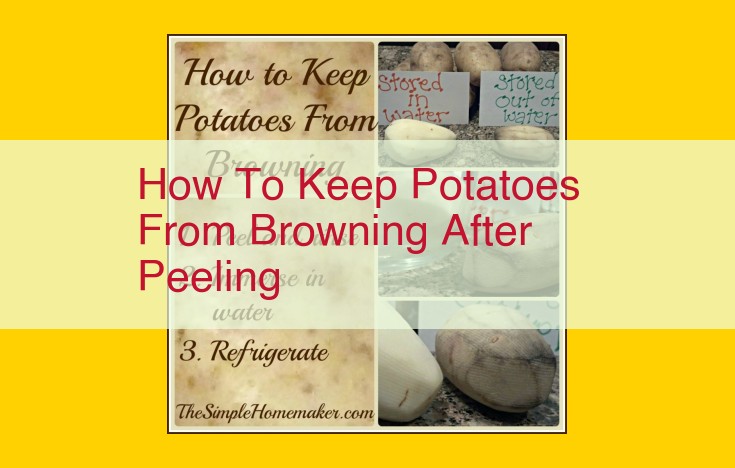To prevent cut potatoes from browning, various methods can be employed. Acids like lemon juice, vinegar, or sodium metabisulfite inhibit the enzyme responsible for browning. Physical barriers, such as submerging potatoes in water or vacuum sealing them, limit oxygen exposure. The browning process can also be slowed down by chemical reactions involving acids and by reducing oxygen levels through vacuum sealing. Selecting potato varieties less prone to browning, storing them properly, and minimizing oxygen exposure during preparation are additional effective measures to maintain their fresh appearance.
Acids and Preservatives: Inhibiting the Browning of Cut Potatoes
The tantalizing sight of fresh cut potatoes can quickly turn to dismay as their vibrant white flesh transforms into an unsightly brown. This unappetizing change is a result of enzymatic browning, a natural defense mechanism that occurs when potatoes are exposed to oxygen.
Fortunately, there are several culinary techniques that can effectively inhibit the browning of cut potatoes. One of the most effective methods is by using acids or preservatives. These substances work by interfering with the action of polyphenol oxidase, the enzyme responsible for triggering the browning process.
The Magic of Acids
Acids, such as lemon juice, vinegar, or citric acid, can be applied to cut potatoes to create an acidic environment. This acidic environment denatures the polyphenol oxidase enzyme, preventing it from initiating the oxidation process. Lemon juice is a particularly popular choice due to its accessibility and mild flavor profile.
The Power of Preservatives
Preservatives, such as sodium metabisulfite, are also effective in preventing browning. Sodium metabisulfite works by binding with the free oxygen that would normally react with the potato flesh, thereby slowing down the oxidation process. This preservative is often used in commercial food applications, but it can also be purchased for home use.
Tips for Using Acids and Preservatives
- Apply acids or preservatives immediately after cutting the potatoes. This will provide the best protection against browning.
- Submerge the potatoes in the acidic solution or toss them with the preservative to ensure thorough coverage.
- Use the appropriate concentration of acid or preservative. Too much can alter the taste of the potatoes, while too little may be ineffective.
- Store the prepared potatoes in an airtight container to prevent the reintroduction of oxygen, which can accelerate browning.
Physical Barriers: Keeping Oxygen at Bay
When you slice a potato, its tender flesh becomes exposed to the air, initiating an unwanted transformation. Oxygen, the catalyst of this metamorphosis, triggers a cascade of reactions that lead to unsightly browning.
But fear not, for we have physical barriers to shield your potatoes from this culinary nemesis. These ingenious methods create an impenetrable barrier against oxygen, ensuring that your potatoes remain pristine and inviting.
Submersion in Serenity:
Immerse your cut potatoes in a serene bath of cold water. This liquid sanctuary envelops each piece, blocking oxygen’s relentless attack. The water molecules form a protective shield, preventing the enzyme responsible for browning from accessing the potato’s surface.
The Vacuum Seal: Airtight Armor
Vacuum sealing is another formidable ally in the fight against browning. This technique involves placing your potatoes in an airtight bag and extracting every last vestige of air. The resulting anaerobic environment starves the browning enzyme of its essential oxygen supply, effectively halting its damaging effects.
Preserving Potato Perfection
By employing these physical barriers, you can preserve the vibrant beauty of your cut potatoes. Whether you choose to submerge them in water or vacuum seal them, you ensure that they will emerge from storage as fresh and unblemished as the day they were sliced.
Chemical Reactions: Unlocking the Secrets of Potato Browning
Potatoes, a culinary staple, possess a hidden secret that can quickly turn them from pristine white to unsightly brown. This transformation, known as enzymatic browning, is triggered by an enzyme called polyphenol oxidase (PPO) reacting with oxygen in the air.
To combat this enzymatic browning, chemists have devised clever strategies that target both PPO and oxygen. Acids, like lemon juice or vinegar, step into the ring as PPO inhibitors. They bind to the enzyme, preventing it from interacting with oxygen and triggering the browning process.
On the other hand, vacuum sealing offers a physical barrier against oxygen, effectively reducing its presence and slowing down the oxidation process. This method is a powerful ally in the quest to maintain potato whiteness.
By understanding the chemical reactions behind potato browning, we gain the power to harness these strategies and preserve the visual appeal of our beloved potatoes.
Other Factors Influencing Potato Browning
Beyond the primary methods of acid inhibition, physical barriers, and chemical reactions, there are several other factors that can impact the browning of cut potatoes. Understanding these factors can help you optimize your storage and preparation techniques to maintain the freshness and appeal of your potatoes.
Potato Variety
Different potato varieties have varying levels of susceptibility to browning. Waxy potatoes, such as Red Bliss and Yukon Gold, generally have lower levels of polyphenol oxidase and are less prone to browning. On the other hand, starchy potatoes, such as Russet and Idaho, have higher levels of the enzyme and are more likely to brown quickly. When choosing potatoes for storage or cooking, consider the variety and its tendency to oxidize.
Storage Conditions
The storage environment can significantly affect the rate of potato browning. Storing potatoes in a cool, dark place slows down the enzymatic reactions that lead to browning. Exposure to light, especially fluorescent lighting, can accelerate the process. High humidity can also contribute to browning, as water droplets can provide a medium for enzymatic reactions.
Oxygen Exposure
As mentioned earlier, oxygen is the primary catalyst for potato browning. Minimizing oxygen exposure can effectively prevent this discoloration. Submerging potatoes in water, using an airtight container, or vacuum sealing them creates a barrier against the air, slowing down the oxidation process and preserving the potatoes’ freshness.
